

人无完人,持之以恒,方能见真我!!!
共同进步!!
一、用栈实现队列
题目链接:用栈实现队列
还是先来看看题目描述:
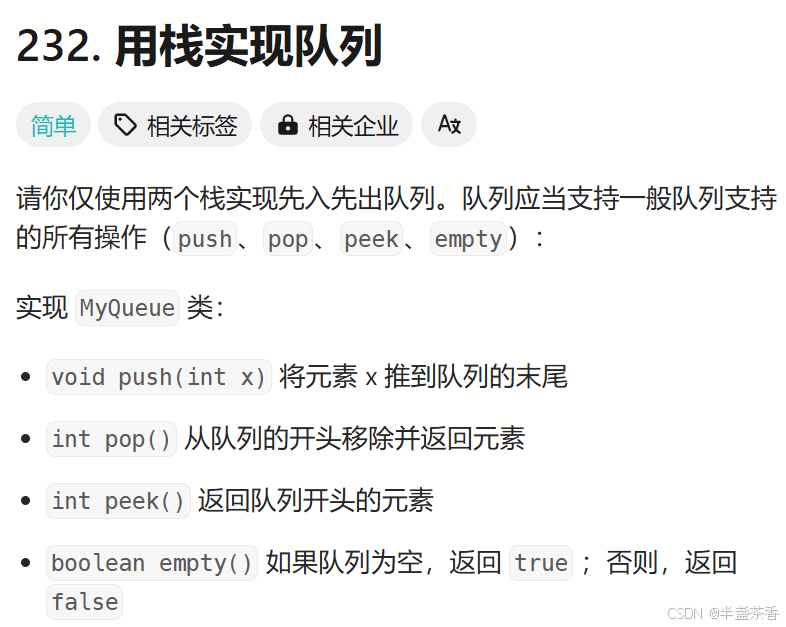
1.大致思路分析
题目的大致含义就是要求我们使用两个栈模拟实现一个队列,要求要支持一个队列的基本操作,这些操作大致都写在上面说明了,关键我们要构思一下怎么用两个栈实现队列的操作
我们都知道栈的特点是先进后出,而队列是先进先出,刚好是相反的,是不是可以从这个方面下手,一个栈和队列是相反的,那么两个栈反复倒腾呢?是不是就能“负负得正”?我们画图来实践一下:
题目的大致含义就是要求我们使用两个栈实现一个队列,要求要支持一个队列的基本操作,这些操作大致都写在上面说明了,关键我们要构思一下怎么用两个栈实现队列的操作
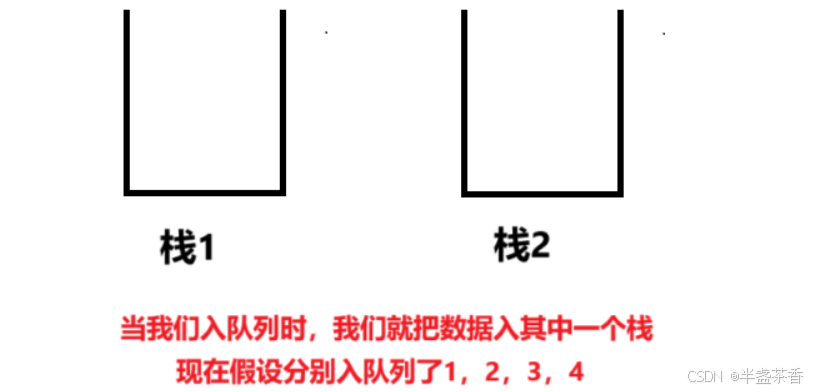
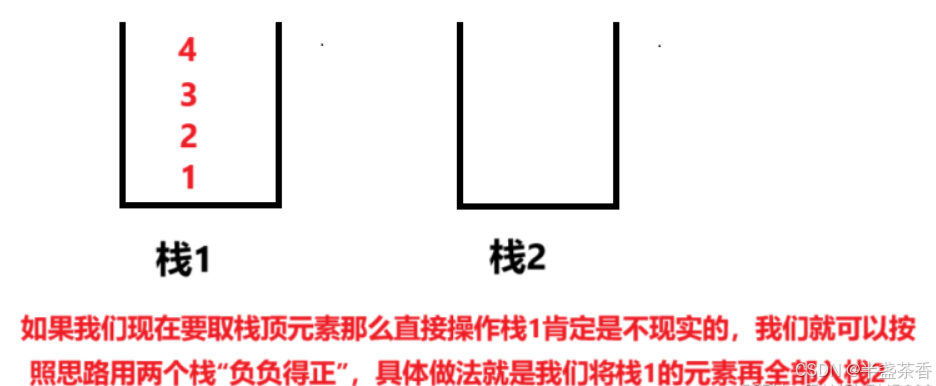
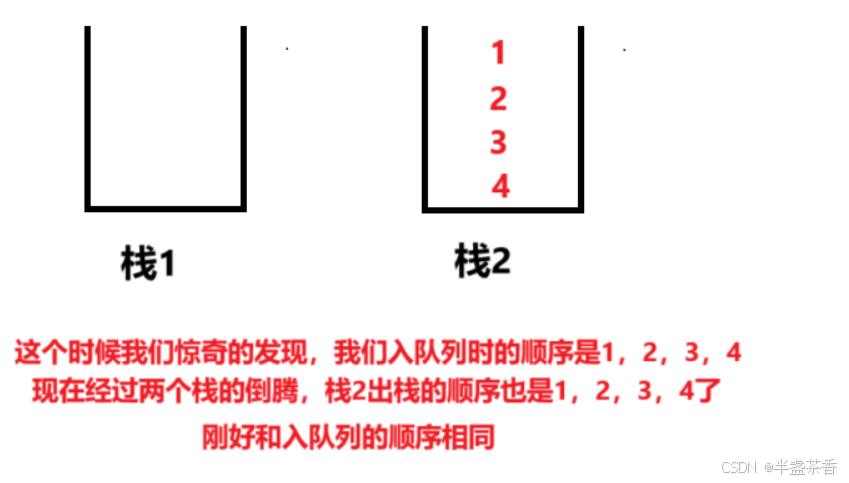
根据上面我们画的图例,发现我们的想法确实奏效,虽然一个栈和队列的性质刚好相反,但是经过两个栈的倒腾,刚好负负得正,实现先进先出
但是上面也只是我们的大致思路,我们只讨论了第一次入队列的情况,那么下一次我们入队列要把数据放在哪个栈中呢?
很明显就是栈1,因为栈2现在的顺序是正确的,只要正常的出栈,那么就可以模拟出队列的顺序,所以不能扰乱栈2的顺序
所以我们可以得出,栈1就是我们用来入队列,而栈2则负责出队列操作,当栈2的元素已经出完之后,我们就可以再次把栈1的所有元素再放进栈2,然后再由栈2来出队列,栈1来入队列,如此循环就基本实现了队列的功能,接下来我们就一个函数一个函数分析:
2.用栈实现队列的结构以及初始化
这个新队列的结构在题目中也已经提到,就是两个栈,所以我们定义两个栈作为这个新队列的结构,但是我们注意,根据刚刚的分析我们知道,其中一个栈用来入队列,另一个专门用来出队列,所以我们可以取stpush和stpop来进行分辨,如下:
typedef struct
{
ST stpush;
ST stpop;
} MyQueue;
- 1
- 2
- 3
- 4
- 5
初始化方法也很简单,就是我们申请一个这样的节点大小的空间,然后分别调用栈的初始化函数来对两个栈初始化,如下:
MyQueue* myQueueCreate()
{
myQueue* pq = (myQueue*)malloc(sizeof(myQueue));
if(pq == NULL)
{
perror("malloc fail\n");
return NULL;
}
STInit(&pq->stpush);//初始化栈1
STInit(&pq->stpop); //初始化栈2
return pq;
}
- 1
- 2
- 3
- 4
- 5
- 6
- 7
- 8
- 9
- 10
- 11
- 12
3.入队列
在之前我们分析过,两个栈中stpush这个栈用来专门入数据,也就是入队列,所以我们在入队列函数中直接将数据入到stpush栈中,如下:
void myQueuePush(MyQueue* obj, int x)
{
STPush(&obj->stpush,x);//入栈1,入队列
}
- 1
- 2
- 3
- 4
4.出队列并返回原队头元素
stpop栈用来专门出队列的,实现出队列的逻辑就是,如果stpop栈不为空,那么我们直接就先保存;原队头元素,然后让stpop出栈,然后返回保存的队头
但是如果stpop栈为空,我们就需要先把stpush栈中的元素全部放到stpop栈中,放完之后再进行上面的操作,如下:
int myQueuePop(MyQueue* obj)
{
if(STEmpty(&obj->stpop))//如果出队列栈为空,就循环入栈
{
while(!STEmpty(&obj->stpush))//将入队列栈全部移入stpop
{
int top = STTop(&obj->stpush);//取出栈1的栈顶元素压栈
STPop(&obj->stpush);
STPush(&obj->stpop,top);//压入栈2
}
}
//通过上面的压栈,stpop栈中已有元素,此时可以出栈
//栈不为空
int top = S TTop(&obj->stpop);
STPop(&obj->stpop);
return top;
}
- 1
- 2
- 3
- 4
- 5
- 6
- 7
- 8
- 9
- 10
- 11
- 12
- 13
- 14
- 15
- 16
- 17
5.返回队头元素
返回队头元素的逻辑跟上面的出队列操作差不多,如果stpop不为空那么直接返回栈顶元素(队头元素),如果stpop为空那么就先把stpush中的元素移动到stpop栈中,然后再去返回栈顶元素
跟上面出栈操作的唯一区别就是不用出栈,只用去取栈顶元素,如下:
int myQueuePeek(MyQueue* obj)
{
if(STEmpty(&obj->stpop))//如果出队列栈为空,就循环入栈
{
while(!STEmpty(&obj->stpush))//将入队列栈全部移入stpop
{
int top = STTop(&obj->stpush);//取出栈1的栈顶元素压栈
STPop(&obj->stpush);
STPush(&obj->stpop,top);//压入栈2
}
}
return STTop(&obj->stpop);
}
- 1
- 2
- 3
- 4
- 5
- 6
- 7
- 8
- 9
- 10
- 11
- 12
- 13
6.队列判空和队列销毁
我们用两个栈实现的队列要判空的话,必须保证两个栈同时为空队列才为空,否则就不是空,如下:
bool myQueueEmpty(MyQueue* obj)
{
return STEmpty(&obj->stpush) && STEmpty(&obj->stpop);
}
- 1
- 2
- 3
- 4
队列销毁的本质也就是销毁里面的两个栈,但是由于我们的MyQueue这个指针也是我们动态申请的,也要释放掉,然后置空,如下:
void myQueueFree(MyQueue* obj)
{
STDestroy(&obj->stpush);
STDestroy(&obj->stpop);
free(obj);
obj = NULL;
}
- 1
- 2
- 3
- 4
- 5
- 6
- 7
7.完整题解代码
那么关于栈的代码,大家就可以自行拷贝了,在这里拷贝也显得冗余了
typedef struct //定义两个栈的结构
{
ST stpush;
ST stpop;
} MyQueue;
MyQueue* myQueueCreate()
{
myQueue* pq = (myQueue*)malloc(sizeof(myQueue));
if(pq == NULL)
{
perror("malloc fail\n");
return NULL;
}
STInit(&pq->stpush);//初始化栈1
STInit(&pq->stpop); //初始化栈2
}
void myQueuePush(MyQueue* obj, int x)
{
STPush(&obj->stpush,x);//入栈1,入队列
}
int myQueuePop(MyQueue* obj)
{
if(STEmpty(&obj->stpop))//如果出队列栈为空,就循环入栈
{
while(!STEmpty(&obj->stpush))//将入队列栈全部移入stpop
{
int top = STTop(&obj->stpush);//取出栈1的栈顶元素压栈
STPop(&obj->stpush);
STPush(&obj->stpop,top);//压入栈2
}
}
//通过上面的压栈,stpop栈中已有元素,此时可以出栈
//栈不为空
int top = S TTop(&obj->stpop);
STPop(&obj->stpop);
return top;
}
int myQueuePeek(MyQueue* obj)
{
if(STEmpty(&obj->stpop))//如果出队列栈为空,就循环入栈
{
while(!STEmpty(&obj->stpush))//将入队列栈全部移入stpop
{
int top = STTop(&obj->stpush);//取出栈1的栈顶元素压栈
STPop(&obj->stpush);
STPush(&obj->stpop,top);//压入栈2
}
}
return STTop(&obj->stpop);
}
bool myQueueEmpty(MyQueue* obj)
{
return STEmpty(&obj->stpush) && STEmpty(&obj->stpop);
}
void myQueueFree(MyQueue* obj)
{
STDestroy(&obj->stpush);
STDestroy(&obj->stpop);
free(obj);
obj = NULL;
}
- 1
- 2
- 3
- 4
- 5
- 6
- 7
- 8
- 9
- 10
- 11
- 12
- 13
- 14
- 15
- 16
- 17
- 18
- 19
- 20
- 21
- 22
- 23
- 24
- 25
- 26
- 27
- 28
- 29
- 30
- 31
- 32
- 33
- 34
- 35
- 36
- 37
- 38
- 39
- 40
- 41
- 42
- 43
- 44
- 45
- 46
- 47
- 48
- 49
- 50
- 51
- 52
- 53
- 54
- 55
- 56
- 57
- 58
- 59
- 60
- 61
- 62
- 63
- 64
- 65
- 66
- 67
- 68
二、用队列实现栈
题目链接:用队列实现栈
还是先来看看题目:
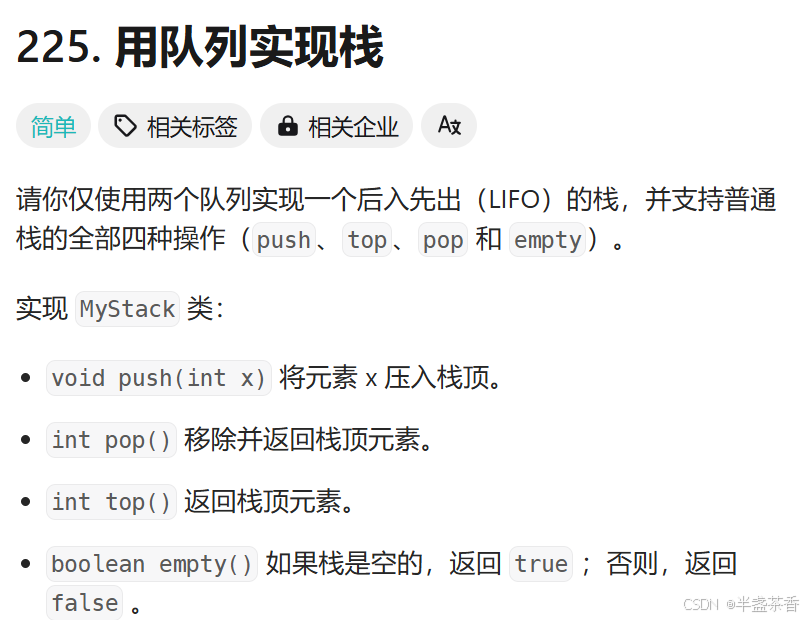
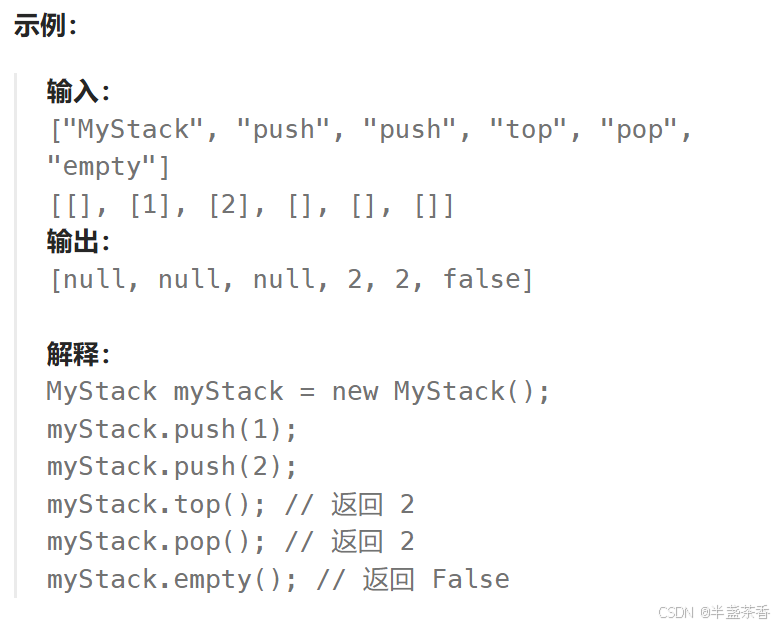
1.大致思路分析
这道题和上道题类似,就是使用两个队列实现一个栈的各种操作,这道题要比上一题难,因为在上一题中,我们的思路就是“负负得正”,通过两个栈的互相倒腾就可以还原队列的入队列出队列操作,但是这题不行,我们画个图看看:

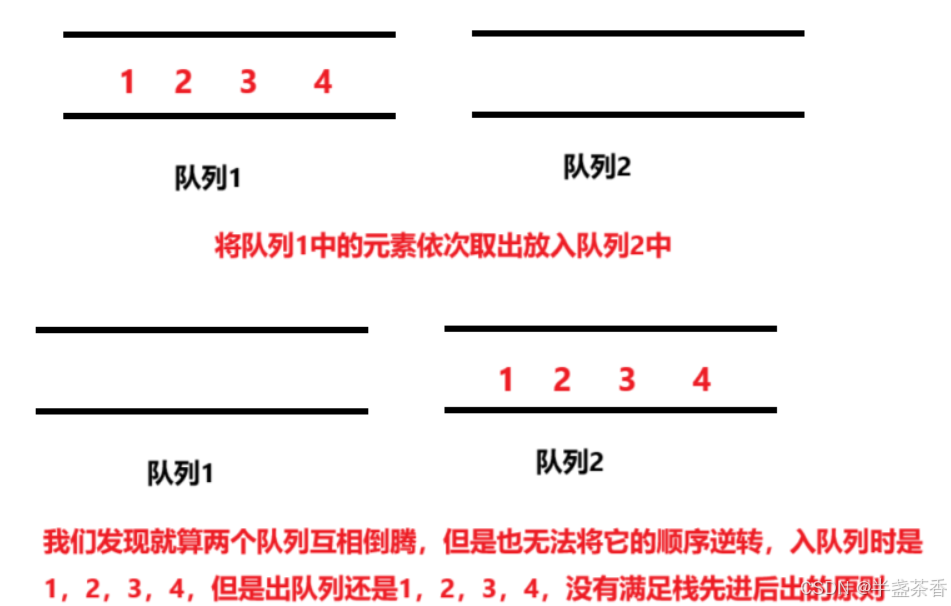
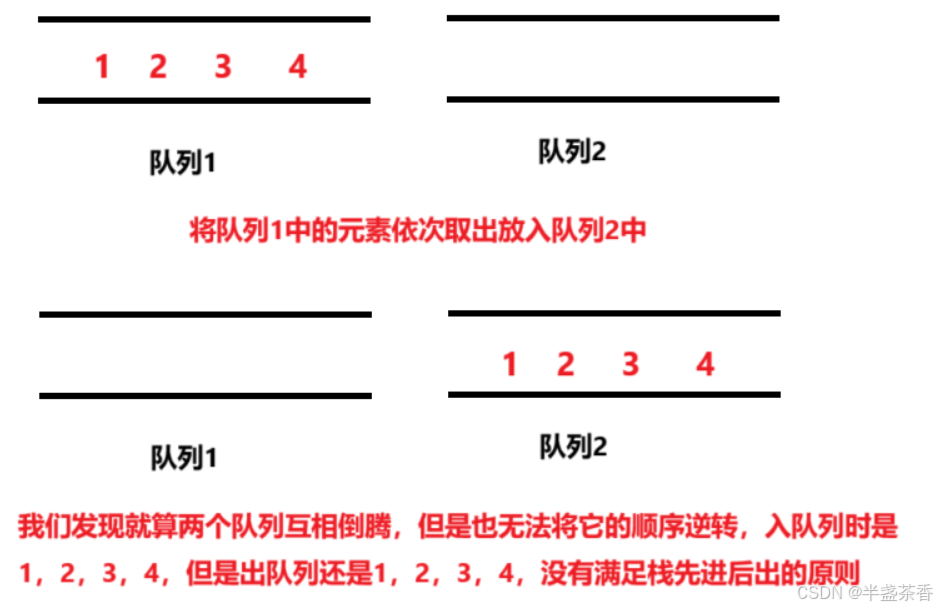
根据上图的分析,我们知道了完全使用上一题的思路行不通,因为栈通过两次倒腾后,里面的元素顺序会反过来,但是队列通过两次倒腾后,里面元素的顺序还是不变
所以我们要换个思路,我们先来看看出栈的思路: 我们把数据入到队列1中,然后移动到队列2时,不全部挪过去,只留下一个,如图:

这个时候我们发现队列1中留下的,对应到栈上不正是我们的栈顶元素吗?我们在出栈的时候就可以把队列1中剩下的一个元素出队列,4是最后入栈的,最后第一个出栈,符合我们栈的性质
那么为了保险起见,我们再试一次,先假设我们实现的栈出栈一次,就是把4删掉,让剩下的1,2,3再来模拟一次出栈,如图:
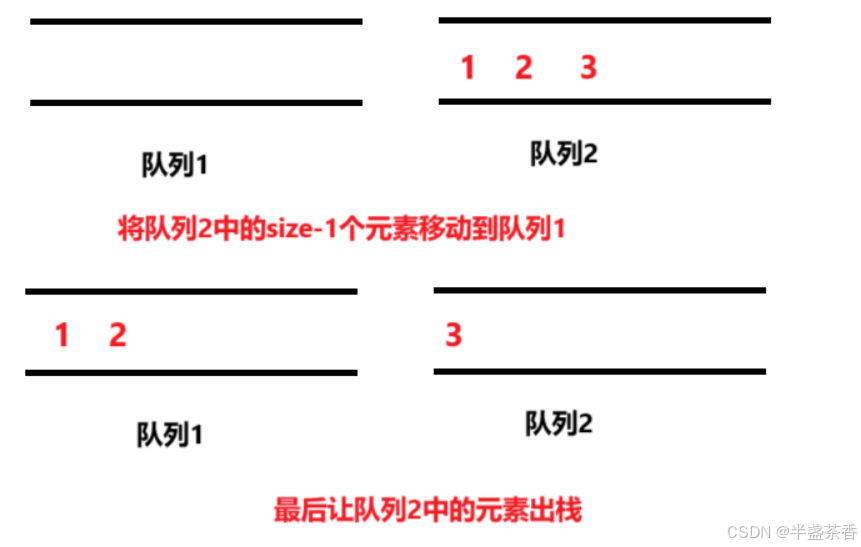
此时我们发现队列2中留下的正好是新的栈顶元素,让队列2出队列就刚好对应了出栈操作,所以我们的出栈思路大致是正确的
但是我们发现,队列1和队列2是反复倒腾的,没有哪个是专门出栈,哪个专门入栈的,所以我们接下来要分清怎么判断哪个队列什么时候用来入栈,什么时候用来出栈
经过规律总结我们发现,当我们要出栈的时候,有一个队列总是空着的,另一个队列里面才装有数据,我们在操作时就是让不为空的队列将size-1个元素挪到空队列里面去,然后不为空的队列就只剩下一个元素出队列即可模拟实现出栈
那么我们入栈的时候,就是往不为空的队列中去入,所以我们在写入栈和出栈操作时最重要的就时判断出哪个队列空,哪个队列不为空,才方便进行操作,那么接下来我们就一个函数一个函数分析
2.用队列实现栈的结构和初始化
既然题目明确要求我们用两个队列实现一个栈,所以栈的结构实际上就是两个队列,如下:
typedef struct
{
Queue q1;//队列1
Queue q2;//队列2
} MyStack;
- 1
- 2
- 3
- 4
- 5
初始化也很简单,首先动态开辟一个MyStack大小的空间,然后就只需要调用队列的初始化方法分别初始化两个队列即可,如下:
MyStack* myStackCreate()
{
MyStack* st = (MyStack*)malloc(sizeof(MyStack));
if(st == NULL)
{
perror("malloc fail\n");
return NULL;
}
QueueInit(&st->q1);
QueueInit(&st->q2);
return st;
}
- 1
- 2
- 3
- 4
- 5
- 6
- 7
- 8
- 9
- 10
- 11
- 12
3.入栈
我们刚刚分析过了,我们入栈就是往不为空的队列中去入,所以我们在入栈时只需要判断一下哪个栈不为空即可,如下:
void myStackPush(MyStack* obj, int x)
{
//往不是空栈的栈中放数据,如果都是空那么无所谓
if(!QueueEmpty(&obj->q1))
{
QueuePush(&obj->q1,x);
}
else
{
QueuePush(&obj->q2,x);
}
}
- 1
- 2
- 3
- 4
- 5
- 6
- 7
- 8
- 9
- 10
- 11
- 12
4.出栈
我们的出栈操作刚刚也重点分析了,就是先找出哪个是空队列,哪个是非空队列,然后将非空队列中size-1个数据挪动到空队列中,然后非空队列剩下的一个元素就是我们要出栈的元素,题目要求出栈前返回栈顶元素,所以我们创建一个变量用来保存栈顶元素,最后用来返回即可,如下:
int myStackPop(MyStack* obj)
{
//先假设q1是空队列,q2是非空队列
Queue* empty = &obj->q1;
Queue* noempty = &obj->q2;
//如果q1非空,那么q2就是空队列,q1为非空队列
if(!QueueEmpty(&obj->q1))
{
empty = &obj->q2;
noempty = &obj->q1;
}
//找到非空队列要移动的size-1的大小
int sum = QueueSize(noempty) - 1;
//找到大小后,循环移动
while(sum--)
{
//取出队头元素放入空队列
int top = QueueFront(noempty);
QueuePop(noempty);
QueuePush(empty,top);
}
//最后保存非空队列剩余的栈顶元素,就可以出栈了
int top = QueueFront(noempty);
QueuePop(noempty);
return top;
}
- 1
- 2
- 3
- 4
- 5
- 6
- 7
- 8
- 9
- 10
- 11
- 12
- 13
- 14
- 15
- 16
- 17
- 18
- 19
- 20
- 21
- 22
- 23
- 24
- 25
- 26
5.取栈顶元素
按照我们上面的思想,取栈顶元素其实就是取非空队列中的队尾元素,如下:
int myStackTop(MyStack* obj)
{
//取栈顶元素,其实就是返回非空队列的队尾元素
if(!QueueEmpty(&obj->q1))
{
return QueueBack(&obj->q1);
}
else
{
return QueueBack(&obj->q2);
}
}
- 1
- 2
- 3
- 4
- 5
- 6
- 7
- 8
- 9
- 10
- 11
- 12
6.判空和销毁栈
只有两个队列同时为空,我们的栈才为空,如下:
bool myStackEmpty(MyStack* obj)
{
return QueueEmpty(&obj->q1) && QueueEmpty(&obj->q2);
}
- 1
- 2
- 3
- 4
销毁栈就只需要调用队列的销毁函数,分别销毁掉两个队列即可,不要忘了最后把整个栈的结构也销毁掉,如下:
void myStackFree(MyStack* obj)
{
QueueDestroy(&obj->q1);
QueueDestroy(&obj->q2);
free(obj);
obj = NULL;
}
- 1
- 2
- 3
- 4
- 5
- 6
- 7
7.完整题解
typedef int QDataType;
//队列中一个节点的定义
//看起来和链表差不多
//但是要注意这里它已经变成队列的节点了
typedef struct QueueNode
{
QDataType data;
struct QueueNode* next;
}QueueNode;
//真正使用的对列的定义
typedef struct Queue
{
int size;
//指向队头的指针
QueueNode* phead;
//指向队尾的指针
QueueNode* ptail;
}Queue;
//队列的初始化
void QueueInit(Queue* pq)
{
assert(pq);
pq->size = 0;
pq->phead = pq->ptail = NULL;//首尾置空
}
//队列的销毁
void QueueDestroy(Queue* pq)
{
assert(pq);
QueueNode* pcur = pq->phead;
while (pcur)//循环置空
{
QueueNode* del = pcur;//保存释放节点
pcur = pcur->next;
free(del);
del = NULL;
}
pq->phead = pq->ptail = NULL;
pq->size = 0;
}
//队列的节点申请
QueueNode* QueueBuyNode(QDataType x)
{
QueueNode* newnode = (QueueNode*)malloc(sizeof(QueueNode));
if (newnode == NULL)
{
perror("malloc fail\n");
return NULL;
}
newnode->data = x;
newnode->next = NULL;
return newnode;
}
//入队列
void QueuePush(Queue* pq, QDataType x)
{
assert(pq);
QueueNode* newnode = QueueBuyNode(x);
//如果队列中没有节点
if (pq->phead == NULL)
{
pq->phead = pq->ptail = newnode;
pq->size++;
return;
}
//队列中已有节点
pq->ptail->next = newnode;//链接
pq->ptail = newnode;//更新尾结点
pq->size++;
}
//队列判空
bool QueueEmpty(Queue* pq)
{
assert(pq);
return pq->phead == NULL;
}
//出队列
void QueuePop(Queue* pq)
{
assert(!QueueEmpty(pq));
QueueNode* next = pq->phead->next;
free(pq->phead);
pq->phead = next;
pq->size--;
}
//取队头元素
QDataType QueueFront(Queue* pq)
{
assert(pq);
return pq->phead->data;
}
//取队尾元素
QDataType QueueBack(Queue* pq)
{
assert(pq);
return pq->ptail->data;
}
//队列的有效元素个数
int QueueSize(Queue* pq)
{
assert(pq);
return pq->size;
}
typedef struct
{
Queue q1;//队列1
Queue q2;//队列2
} MyStack;
MyStack* myStackCreate()
{
MyStack* st = (MyStack*)malloc(sizeof(MyStack));
if(st == NULL)
{
perror("malloc fail\n");
return NULL;
}
QueueInit(&st->q1);
QueueInit(&st->q2);
return st;
}
void myStackPush(MyStack* obj, int x)
{
//往不是空栈的栈中放数据,如果都是空那么无所谓
if(!QueueEmpty(&obj->q1))
{
QueuePush(&obj->q1,x);
}
else
{
QueuePush(&obj->q2,x);
}
}
int myStackPop(MyStack* obj)
{
//先假设q1是空队列,q2是非空队列
Queue* empty = &obj->q1;
Queue* noempty = &obj->q2;
//如果q1非空,那么q2就是空队列,q1为非空队列
if(!QueueEmpty(&obj->q1))
{
empty = &obj->q2;
noempty = &obj->q1;
}
//找到非空队列要移动的size-1的大小
int sum = QueueSize(noempty) - 1;
//找到大小后,循环移动
while(sum--)
{
//取出队头元素放入空队列
int top = QueueFront(noempty);
QueuePop(noempty);
QueuePush(empty,top);
}
//最后保存非空队列剩余的栈顶元素,就可以出栈了
int top = QueueFront(noempty);
QueuePop(noempty);
return top;
}
int myStackTop(MyStack* obj)
{
//取栈顶元素,其实就是返回非空队列的队尾元素
if(!QueueEmpty(&obj->q1))
{
return QueueBack(&obj->q1);
}
else
{
return QueueBack(&obj->q2);
}
}
bool myStackEmpty(MyStack* obj)
{
return QueueEmpty(&obj->q1) && QueueEmpty(&obj->q2);
}
void myStackFree(MyStack* obj)
{
QueueDestroy(&obj->q1);
QueueDestroy(&obj->q2);
free(obj);
obj = NULL;
}
- 1
- 2
- 3
- 4
- 5
- 6
- 7
- 8
- 9
- 10
- 11
- 12
- 13
- 14
- 15
- 16
- 17
- 18
- 19
- 20
- 21
- 22
- 23
- 24
- 25
- 26
- 27
- 28
- 29
- 30
- 31
- 32
- 33
- 34
- 35
- 36
- 37
- 38
- 39
- 40
- 41
- 42
- 43
- 44
- 45
- 46
- 47
- 48
- 49
- 50
- 51
- 52
- 53
- 54
- 55
- 56
- 57
- 58
- 59
- 60
- 61
- 62
- 63
- 64
- 65
- 66
- 67
- 68
- 69
- 70
- 71
- 72
- 73
- 74
- 75
- 76
- 77
- 78
- 79
- 80
- 81
- 82
- 83
- 84
- 85
- 86
- 87
- 88
- 89
- 90
- 91
- 92
- 93
- 94
- 95
- 96
- 97
- 98
- 99
- 100
- 101
- 102
- 103
- 104
- 105
- 106
- 107
- 108
- 109
- 110
- 111
- 112
- 113
- 114
- 115
- 116
- 117
- 118
- 119
- 120
- 121
- 122
- 123
- 124
- 125
- 126
- 127
- 128
- 129
- 130
- 131
- 132
- 133
- 134
- 135
- 136
- 137
- 138
- 139
- 140
- 141
- 142
- 143
- 144
- 145
- 146
- 147
- 148
- 149
- 150
- 151
- 152
- 153
- 154
- 155
- 156
- 157
- 158
- 159
- 160
- 161
- 162
- 163
- 164
- 165
- 166
- 167
- 168
- 169
- 170
- 171
- 172
- 173
- 174
- 175
- 176
- 177
- 178
- 179
- 180
- 181
- 182
- 183
- 184
- 185
- 186
- 187
- 188
- 189
- 190
- 191
- 192
- 193
- 194
- 195
- 196
- 197
- 198
- 199
- 200
- 201
OK,那么今天的刷题也就到这里了,咱们下一篇再见啦~~
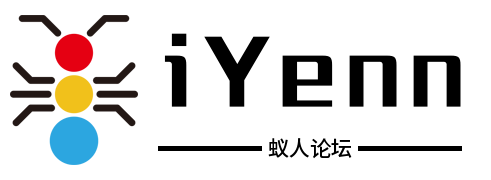

评论记录:
回复评论: